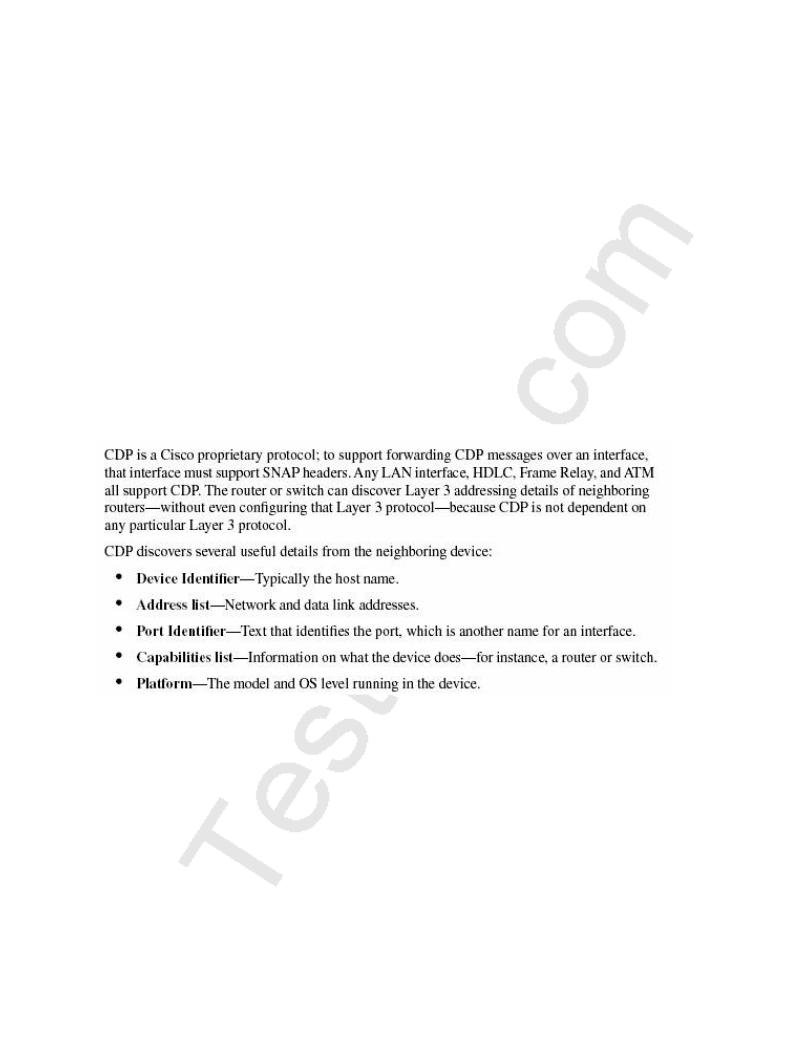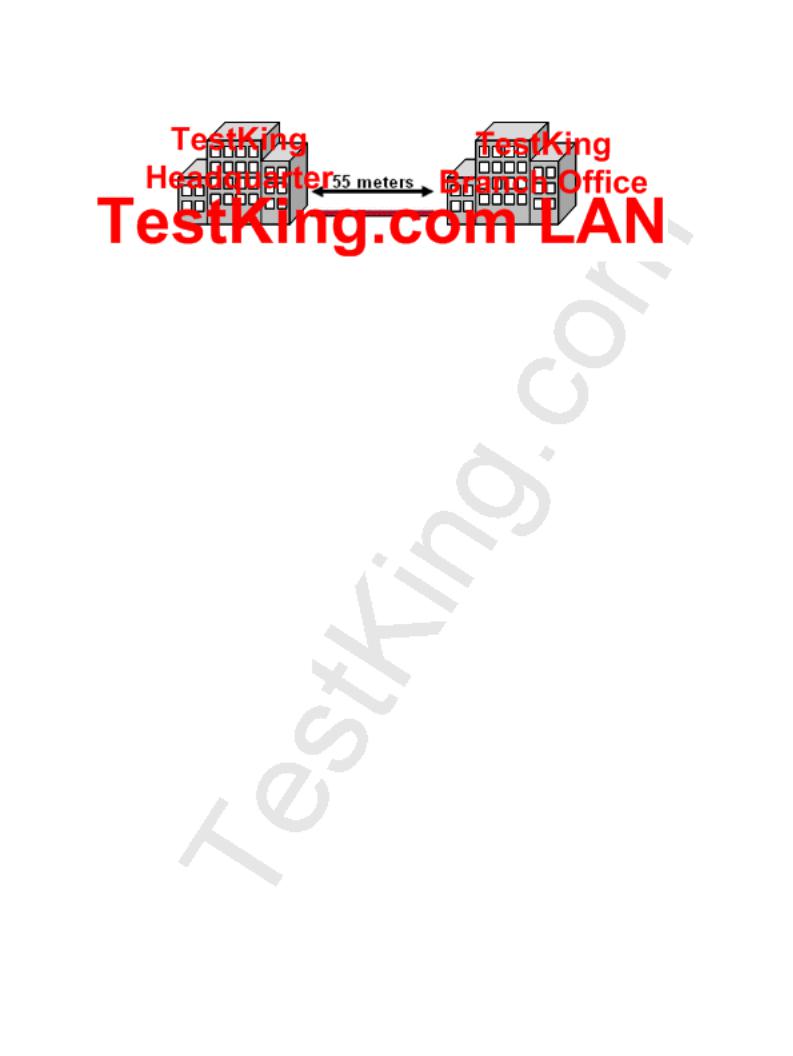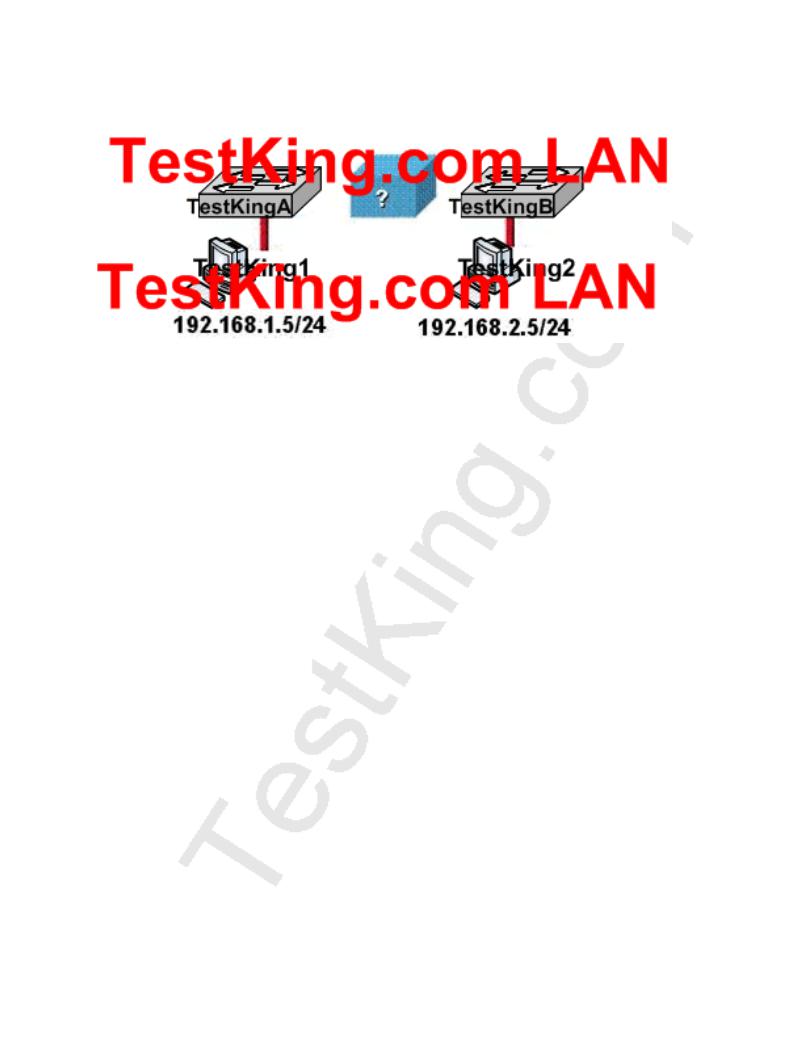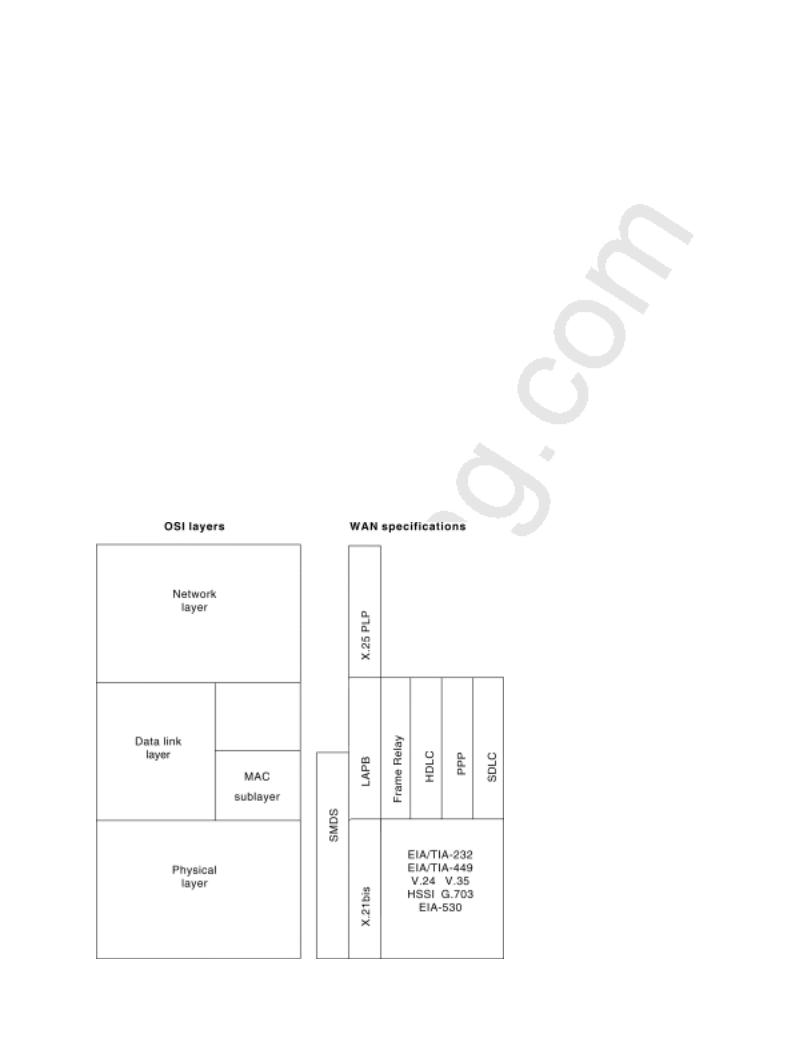
Testking_640-802_V13
.pdf
QUESTION NO: 7
Both bridges are switches are being used throughout the TestKing LAN. Which of the following statements are true regarding bridges and switches in this network? (Choose 3)
A.Switches are primarily software based while bridges are hardware based.
B.Switches usually have a higher number of ports than most bridges.
C.Bridges are frequently faster than switches.
D.Bridges define broadcast domains while switches define collision domains.
E.Both bridges and switches forward Layer 2 broadcasts.
F.Both bridges and switches make forwarding decisions based on Layer 2 addresses.
Answer: B, E, F
QUESTION NO: 8
As a network administrator, you will need to decide on the appropriate network devices to use. Which of the following correctly describes the roles of devices in a WAN? (Choose three)
A.A CSU/DSU terminates a digital local loop.
B.A router is commonly considered a DCE device.
C.A modem terminates an analog local loop.
D.A router is commonly considered a DTE device.
E.A modem terminates a digital local loop.
F.A CSU/DSU terminates an analog local loop.
G.A modem is used to terminate a T1
Answer: A, C, D
QUESTION NO: 9
The TestKing network administrator needs to determine what LAN devices to install on the TestKing network. What are two advantages of using Layer 2 Ethernet switches over hubs? (Choose two)
A. Allowing simultaneous frame transmissions
Leading the way in IT testing and certification tools, www.testking.com
- 11 -

B.Increasing the size of broadcast domains
C.Increasing the maximum length of UTP cabling between devices
D.Filtering frames based on MAC addresses
E.Decreasing the number of collision domains
Answer: A, D
Explanation:
A: A half duplex connection is where only one device can send or receive at a time. A full duplex connection is where both devices can send and receive at the same time.
Thus, if you have a 100Mb half-duplex connection, only sending at 100Mb OR receiving at 100Mb can happen at the same time. If you have a 100Mb full duplex connection, you can effectively get 200Mb out of the link because you could be sending 100Mb and receiving 100Mb at the same time.
D: Switches are capable of filtering frames based on any Layer 2 fields. For example, a switch can be programmed to reject (not forward) all frames sourced from a particular network. Because link layer information often includes a reference to an upper-layer protocol, switches usually can filter on this parameter. Furthermore, filters can be helpful in dealing with unnecessary broadcast and multicast packets.
Section 2: Select the components required to meet a network specification (4 questions)
QUESTION NO: 1
CDP is being used throughout the TestKing network. What are two reasons why the TestKing network administrator would use CDP? (Choose two)
A.To determine the status of network services on a remote device
B.To obtain the IP Address of a connected device in order to telnet to the device
C.To verify the type of cable interconnecting two devices
D.To verify Layer 2 connectivity between two devices when Layer 3 fails
E.To obtain VLAN information from directly connected swticehs
F.To determine the status of the routing protocols between directly connected routers
G.To support automatic network failover during outages
Answer: B, D
Leading the way in IT testing and certification tools, www.testking.com
- 12 -

QUESTION NO: 2
CDP is running between two TestKing devices. What information is supplied by CDP? (Select three)
A.Device Identifiers
B.Capabilities list
C.Platform
D.Route identifier
E.Neighbor traffic data
Answer: A, B, C
Explanation:
QUESTION NO: 3
Two TestKing offices are connected as shown below:
Leading the way in IT testing and certification tools, www.testking.com
- 13 -

Two buildings on the London campus of a the TestKing corporation must be connected to use Ethernet with a bandwidth of at least 100 Mbps. TestKing is concerned about possible problems from voltage potential differences between the two buildings. Which media type should be used for the connection?
A.Coaxial cable
B.Fiber optic cable
C.UTP cable
D.STP cable
E.None of the above
Answer: B Explanation:
Current Ethernet technololgy typically comes via either copper UTP or fiber ccables. In this scenario the distance between the buildings is only 55 meters so either copper or fiber could be used, as the distance limitation for 100M UTP Ethernet is 100 meters. However, fiber would be a better fit as it is not prone to errors that could occur due to the voltage potential differences. Because fiber is a dielectric material, it's not susceptible to electrical interference. FO-product vendors also claim that fiber systems make secure communications easier. Interference immunity and lack of emissions are givens in FO systems and in the fiber medium itself.
QUESTION NO: 4
Refer to the TestKing network shown below:
Leading the way in IT testing and certification tools, www.testking.com
- 14 -

You work as a network technician at TestKing.com. Please study the exhibit carefully. Based on the information shown above, what is needed to allow host TestKing1 to ping host TestKing2?
A.a crossover cable connecting the switches
B.a backbone switch connecting the switches with either fiber optic or straight-through cables
C.a straight-through cable connecting the switches
D.a CSU/DSU connected to the switches with straight-through cables
E.a router connected to the switches with straight-through cables
Answer: E Explanation:
Routers are Layers 3 devices used for inter-network communication. In this scenario there are two different networks, so both switches need to connect to a router using straight-through cables.
A straight-through cable is used to connect two different devices like, switch to router, host to switch. Since we need to insert a router for communication between the two switches, straight through cables will be used between the switches and the router.
Section 3: Use the OSI and TCP/IP models and their associated protocols to explain how data flows in a network (12 questions)
Leading the way in IT testing and certification tools, www.testking.com
- 15 -

QUESTION NO: 1
As a CCNA candidate, you must know the various layers of the OSI model. At which layers of the OSI Model do Wide Area Networks operate in? (Choose two)
A.Physical Layer
B.Datalink Layer
C.Network Layer
D.Session Layer
E.Transport Layer
F.Presentation Layer
G.Application Layer
Answer: A, B
Explanation:
A WAN is a data communications network that covers a relatively broad geographic area and that often uses transmission facilities provided by common carriers, such as telephone companies. WAN technologies generally function at the lower two layers of the OSI reference model: the physical layer and the data link layer as shown below.
Leading the way in IT testing and certification tools, www.testking.com
- 16 -

Note: Occasionally WAN's would also be considered to operate at layer 3, but since this question asked for only 2 chopices layers 1 and 2 are better choices.
QUESTION NO: 2
While troubleshooting a connectivity problem on the network, you issue the ping command from your PC command prompt, but the output shows "request times out."
At which OSI layer is this problem associated with?
A.The data link layer
B.The application layer
C.The access layer
D.The session layer
E.The network layer
Answer: E Explanation:
TCP/IP includes ICMP, a protocol designed to help manage and control the operation of a TCP/IP network. The ICMP protocol provides a wide variety of information about a network's health and operational status. Control message is the most descriptive part of a name. ICMP helps control and manage IP's work and therefore is considered part of TCP/IP's network layer.
Reference:
CCNA Self-Study CCNA ICND exam certification Guide (Cisco Press, ISBN 1-58720-083-X) page 277.
QUESTION NO: 3
You download a file from an FTP site on the Internet. What is the highest layer in the OSI model used in this FTP operation?
A.Application
B.Presentation
C.Session
D.Transport
E.Internet
Leading the way in IT testing and certification tools, www.testking.com
- 17 -

F.Data Link
G.Physical
Answer: A Explanation:
Layer 7 is the application layer, which is the highest layer in the OSI model. This layer describes the use of end user applications, such as opening movie files (avi, mpeg, etc) used Microsoft Office applications, using WWW browsers, using Telnet, and using FTP.
QUESTION NO: 4
A host computer has been correctly configured with a static IP address, but the default gateway is incorrectly set. Which layer of the OSI model will be first affected by this configuration error?
A.Layer 1
B.Layer 2
C.Layer 3
D.Layer 4
E.Layer 5
F.Layer 6
E.Layer 7
Answer: C Explanation:
IP Addressing and IP routing resides on the OSI Network layer, which is layer 3.
QUESTION NO: 5
Which layer of the OSI reference model is responsible for ensuring reliable end-to-end delivery of data?
A.Application
B.Presentation
C.Session
D.Transport
E.Network
F.Data-Link
Leading the way in IT testing and certification tools, www.testking.com
- 18 -

Answer: D Explanation:
A key function of the transport layer is to provide connection services for the protocols and applications that run at the levels above it. These can be categorized as either connection-oriented services or connectionless services. Some protocol suites, such as TCP/IP, provide both a connection-oriented and a connectionless transport layer protocol, to suit the needs of different applications.
The transport layer is also the place in the layer stack where functions are normally included to add features to end-to-end data transport. Where network layer protocols are normally concerned with just "best effort" communications, where delivery is not guaranteed. Transport layer protocols are given intelligence in the form of algorithms that ensure that reliable and efficient communication between devices takes place. This encompasses several related jobs, including lost transmission detection and handling, and managing the rate at which data is sent to ensure that the receiving device is not overwhelmed.
Transmission quality, meaning ensuring that transmissions are received as sent, is so important that some networking references define the transport layer on the basis of reliability and flow-control functions. However, not all transport layer protocols provide these services. Just as a protocol suite may have a connection-oriented and a connectionless transport layer protocol, it may also have one that provides reliability and data management services, and one that does not. Again, this is the case with TCP/IP: there is one main transport layer protocol; TCP, that includes reliability and flow control features, and a second, UDP, that doesn't.
QUESTION NO: 6
At which OSI layer is a logical path created between two host systems named TK1 and TK2 on the TestKing LAN?
A.Physical
B.Session
C.Data link
D.Transport
E.Network
F.Application
G.Presentation
Answer: E
Leading the way in IT testing and certification tools, www.testking.com
- 19 -

QUESTION NO: 7
Which OSI layer is associated with the following: The acknowledgement of transmissions, sequencing, and flow control across a network?
A.Layer 2
B.Layer 3
C.Layer 4
D.Layer 5
E.Layer 6
F.Layer 7
Answer: C Explanation:
The Transport layer (Layer 4) defines several functions, including the choice of protocols. The most important Layer 4 functions are error recovery and flow control. The transport layer may provide for retransmission, i.e., error recovery, and may use flow control to prevent unnecessary congestion by attempting to send data at a rate that the network can accommodate, or it might not, depending on the choice of protocols. Multiplexing of incoming data for different flows to applications on the same host is also performed. Reordering of the incoming data stream when packets arrive out of order is included. Examples include: TCP, UDP, and SPX.
QUESTION NO: 8
Which OSI layer header contains the address of a destination host that is on another network?
A.Application
B.Presentation
C.Session
D.Transport
E.Network
F.Data link
G.Physical
Answer: E
Leading the way in IT testing and certification tools, www.testking.com
- 20 -
